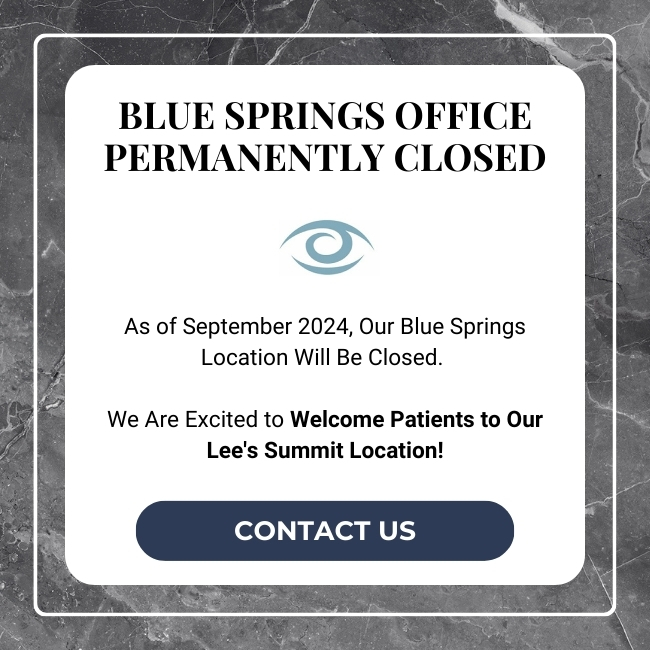Understanding the Link Between Diabetes & Vision
Diabetes is a chronic disease that affects the body’s use of blood glucose (blood sugar). While most people know how diabetes can impact heart or kidney health, few realize the potential harm it can cause to eye health and vision.
Diabetic eye disease can develop when blood sugar levels are uncontrolled, leading to vision loss or even blindness if left untreated.
At Lee’s Summit Family Eyecare, we’re committed to helping our patients preserve healthy, clear vision. Whether you’re an adult recently diagnosed with type 2 diabetes or are managing lifelong type 1 diabetes, regular diabetic eye exams are a crucial part of protecting your sight.
Request AppointmentHow Does Diabetes Affect the Eyes?
Uncontrolled diabetes causes elevated blood sugar levels, which can damage the delicate blood vessels in the back of the eyes. This damage often results in fluid leakage, swelling, scarring, or increased eye pressure.
Patients can help protect their vision by:
- Managing the diabetes ABCs, including blood sugar, blood pressure, and cholesterol
- Having a dilated eye exam at least once a year

Cataracts: Clouding the Clear Lens
Cataracts are a common eye condition that occurs when the eye’s lens becomes cloudy. Cataracts can cause:
- Blurred or hazy vision
- Difficulty seeing at night
- Sensitivity to light
- Dull or faded colors
While age-related factors are the primary cause of cataracts, individuals with diabetes have an increased risk. High blood sugar levels can cause the lens to swell, leading to cataracts developing earlier and progressing more rapidly.
Cataract surgery is the only way to remove a cataract, but lifestyle changes and prescription lenses can help improve vision in the early stages.
Glaucoma: The Silent Thief of Sight
Glaucoma is a group of eye diseases characterized by damage to the optic nerve, often associated with increased pressure within the eye. Vision loss begins gradually, eventually leading to complete blindness.
Diabetes can contribute to glaucoma development by affecting the blood vessels that supply the optic nerve. People with diabetes are twice as likely to develop glaucoma and may have an increased risk of developing neovascular glaucoma, a rare but severe form of the disease.
Regular eye exams are essential to detect glaucoma early, as it often presents no symptoms until later stages.
Diabetic Retinopathy: Protecting the Delicate Retina
Diabetic retinopathy is a progressive condition resulting from diabetes. The condition occurs when high blood sugar levels damage the blood vessels in the retina, the light-sensitive tissue lining the back of the eye.
Diabetic retinopathy can cause blood vessels to leak and swell, causing blurry or hazy vision. As the condition progresses, abnormal blood vessels may grow, depriving eye tissue of oxygen and severely impairing vision.
Early detection through regular eye exams is crucial for preventing and managing diabetic retinopathy.
Diabetic Macular Edema: Affecting Central Vision
Diabetic macular edema (DME) is a complication of diabetic retinopathy. High blood sugar levels damage blood vessels in the retina, causing fluid to leak. When fluid accumulates, it can cause swelling in the macula (the central part of the retina responsible for detailed vision).
DME can cause:
- Distorted or blurry vision
- Washed-out or faded colors
- Seeing more floaters
- Double vision
If left untreated, DME can severely impair vision. Regular eye examinations are vital to monitor the progression of diabetic retinopathy and detect DME early.
Monitoring Eye Health Closely Through Technology
People with diabetes have a heightened risk of developing eye problems. However, the good news is that early detection and prompt treatment can significantly help in safeguarding your eyesight.
With regular dilated eye exams, we can closely monitor changes to your eye tissue. This allows us to provide the necessary support for managing your visual health and overall well-being. With diagnostic technology, we can gain in-depth insights into your eye health, tracking changes over time and personalizing treatments to improve outcomes.
Optical Coherence Tomography (OCT)
Optical coherence tomography (OCT) is a noninvasive imaging technique that uses light waves to capture detailed pictures inside the eye. With OCT, we can obtain 3D images of the retina’s layers and measure tissue thickness. The in-depth view helps us monitor tissue changes and detect early signs of eye disease.
Optomap Widefield Retinal Imaging
Optomap creates a digital image of the retina, capturing a wide 200-degree view with just 1 noninvasive scan, a significant improvement over traditional 45-degree scans. This expanded field of view can enhance our ability to monitor the fine details in eye tissue and detect early signs of eye disease.
Visit Us for Your Routine Eye Exam
By understanding the connection between diabetes and eye health, patients can take proactive steps to protect their vision. Regular eye checkups, maintaining stable blood sugar levels, and adopting a healthy lifestyle can significantly reduce the risk of diabetic eye disease. Diabetic eye exams are key to prioritizing your eye health.
We want to help you preserve healthy vision and enhance your quality of life. Schedule a diabetic eye exam today.
Request Appointment

